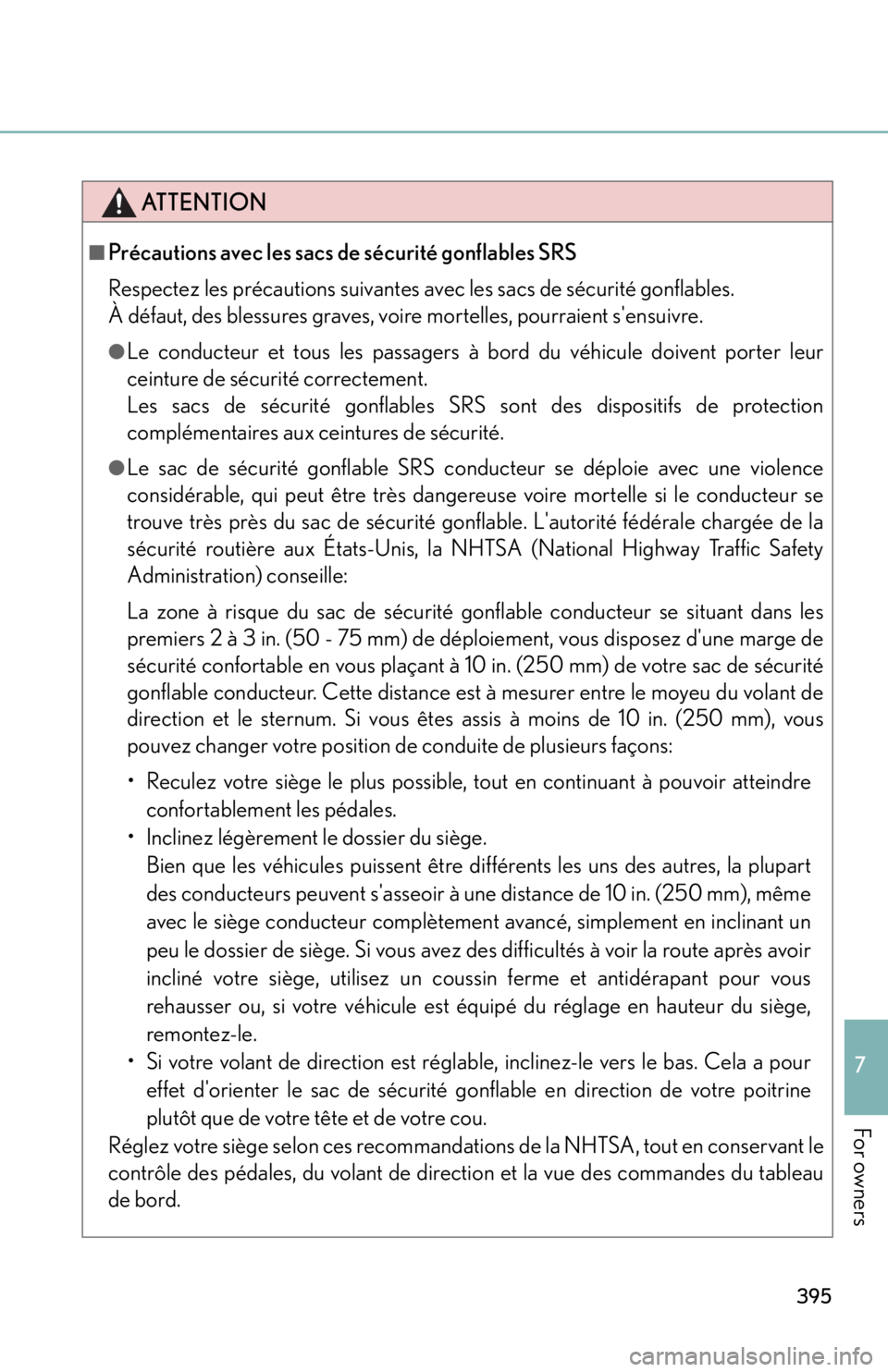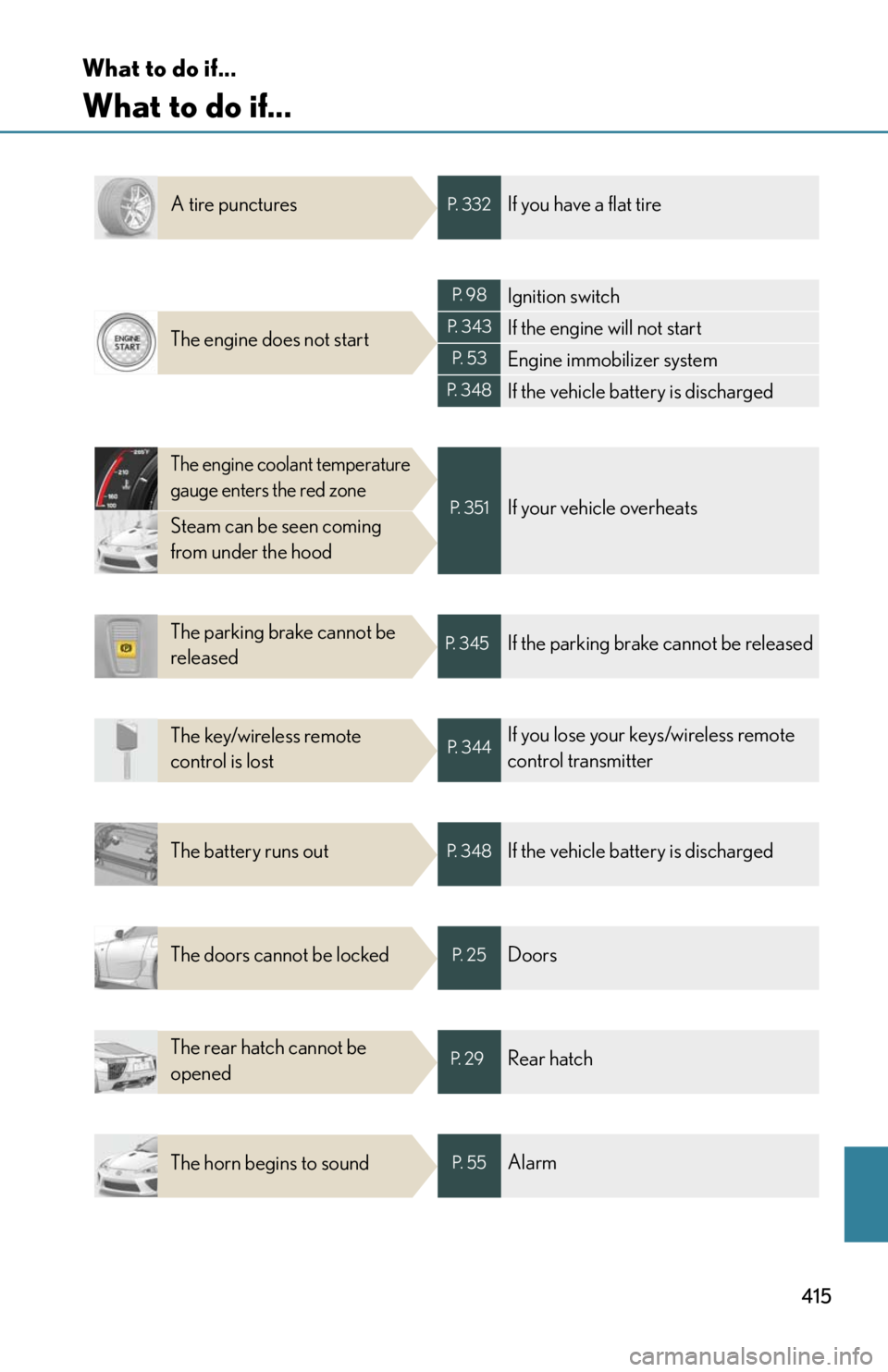2012 Lexus LFA ESP
[x] Cancel search: ESPPage 342 of 420

340
5-2. Steps to take in an emergency
■Sealant
●One tire can be repaired using the bottle of sealant stored in the emergency tire
puncture repair kit.
●The sealant can be used when the outside temperature is from -22°F (-30°C)
to 140°F (60°C).
●When the outside temperature is low, the viscosity of the sealant becomes high
and it will be more difficult to inject th e sealant. In this case, warm the sealant in
the vehicle before using it.
●The sealant has a limited lifespan. The expi ration date is marked on the bottle.
The sealant should be replaced before the expiration date. Contact your Lexus
dealer.
●If the sealant gets on your clothes, it may stain.
●After using the sealant, bring the empty bottle of sealant to your Lexus dealer
and purchase a new bottle. Keep the ne w bottle of sealant in your vehicle.
■Compressor
●The compressor is a pneumatic filling type for passenger vehicles.
●When the compressor is operating, a loud operating noise will be produced.
This does not indicate a malfunction.
■The wheel of a tire that has been repaired
If you remove the sealant adhering to the wheel with a rag, you can reuse the wheel.
■The valve of a tire that has been repaired
●After a tire is repaired with the emergency tire puncture repair kit, the tire pres-
sure warning valve and transm itter should be replaced.
●After a tire is repaired with the emergency tire puncture repair kit, even if the
tire inflation pressure is at the recommended level, the tire pressure warning
light may come on/flash.
Page 378 of 420

376
6-1. Specifications
■Traction AA, A, B, C
The traction grades, from highest to lowest, are AA, A, B and C, and
they represent the tire's ability to stop on wet pavement as measured
under controlled condit ions on specified government test surfaces of
asphalt and concrete.
A tire marked C may have poor traction performance.
Warning: The traction grade assigned to this tire is based on braking
(straight ahead) traction tests and does not include cornering (turning) trac-
tion.
■ Temperature A, B, C
The temperature grades are A (the highest), B, and C, representing
the tire's resistance to the generation of heat and its ability to dissipate
heat when tested under controlled conditions on a specified indoor
laboratory test wheel.
Sustained high temperature can cause the material of the tire to degenerate
and reduce tire life, and excessive temperature can lead to sudden tire fail-
ure.
The grade C corresponds to a level of performance which all passenger car
tires must meet under the Federal Mo tor Vehicle Safety Standard No. 139.
Grades B and A represent higher levels of performance on the laboratory
test wheel than the minimum required by law.
Warning: The temperature grades for this tire are established for a tire that
is properly inflated and not overloaded.
Excessive speed, underinflation, or excess ive loading, either separately or in
combination, can cause heat buildup and possible tire failure.
Page 381 of 420

379
6-1. Specifications
6
Vehicle specifications
Bias ply tireA pneumatic tire in which the ply cords that extend to
the beads are laid at alternate angles substantially
less than 90 degrees to the centerline of the tread
Carcass The tire structure, except tread and sidewall rubber
which, when inflated, bears the load
Chunking The breaking away of pieces of the tread or sidewall
Cord The strands forming the plies in the tire
Cord separation The parting of cords from adjacent rubber com-
pounds
Cracking Any parting within the tread,
sidewall, or innerliner of
the tire extending to cord material
CT A pneumatic tire with an inverted flange tire and rim
system in which the rim is designed with rim flanges
pointed radially inward and the tire is designed to fit
on the underside of the rim in a manner that encloses
the rim flanges inside the air cavity of the tire
Extra load tire A tire designed to operate at higher loads and at
higher inflation pressures than the corresponding
standard tire
Groove The space between two adjacent tread ribs
Innerliner The layer(s) forming the inside surface of a tubeless
tire that contains the inflating medium within the tire
Innerliner separation The parting of the innerliner from cord material in the
carcass
Tire related termMeaning
Page 383 of 420

381
6-1. Specifications
6
Vehicle specifications
Ply separationA parting of rubber comp
ound between adjacent
plies
Pneumatic tire A mechanical device made of rubber, chemicals, fab-
ric and steel or other mate
rials, that, when mounted
on an automotive wheel, provides the traction and
contains the gas or fluid that sustains the load
Radial ply tire A pneumatic tire in which the ply cords that extend to
the beads are laid at substantially 90 degrees to the
centerline of the tread
Reinforced tire A tire designed to operate at higher loads and at
higher inflation pressures than the corresponding
standard tire
Section width The linear distance between the exteriors of the side-
walls of an inflated tire, excluding elevations due to
labeling, decoration, or protective bands
Sidewall That portion of a tire between the tread and bead
Sidewall separation The parting of the rubber
compound from the cord
material in the sidewall
Snow tire A tire that attains a traction index equal to or greater
than 110, compared to the ASTM E-1136 Standard
Reference Test Tire, when using the snow traction test
as described in ASTM F-1805-00, Standard Test
Method for Single Wheel Driving Traction in a
Straight Line on Snow-and Ice-Covered Surfaces,
and which is marked with an Alpine Symbol (
)
on at least one sidewall
Te s t r i m The rim on which a tire is fitted for testing, and may be
any rim listed as appropriate for use with that tire
Tr e a d That portion of a tire that comes into contact with the
road
Tire related termMeaning
Page 397 of 420

395
7
For owners
ATTENTION
■Précautions avec les sacs de sécurité gonflables SRS
Respectez les précautions suivantes avec les sacs de sécurité gonflables.
À défaut, des blessures graves, voire mortelles, pourraient s'ensuivre.
●Le conducteur et tous les passagers à bord du véhicule doivent porter leur
ceinture de sécurité correctement.
Les sacs de sécurité gonflables SRS sont des dispositifs de protection
complémentaires aux ceintures de sécurité.
●Le sac de sécurité gonflable SRS conducteur se déploie avec une violence
considérable, qui peut être très dangereuse voire mortelle si le conducteur se
trouve très près du sac de sécurité gonflable. L'autorité fédérale chargée de la
sécurité routière aux États-Unis, la NHTSA (National Highway Traffic Safety
Administration) conseille:
La zone à risque du sac de sécurité gonflable conducteur se situant dans les
premiers 2 à 3 in. (50 - 75 mm) de déploiement, vous disposez d'une marge de
sécurité confortable en vous plaçant à 10 in. (250 mm) de votre sac de sécurité
gonflable conducteur. Cette distance est à mesurer entre le moyeu du volant de
direction et le sternum. Si vous êtes assis à moins de 10 in. (250 mm), vous
pouvez changer votre position de conduite de plusieurs façons:
Reculez votre siège le plus possible, tout en continuant à pouvoir atteindreconfortablement les pédales.
Inclinez légèrement le dossier du siège. Bien que les véhicules puissent être différents les uns des autres, la plupart
des conducteurs peuvent s'asseoir à une distance de 10 in. (250 mm), même
avec le siège conducteur complètement avancé, simplement en inclinant un
peu le dossier de siège. Si vous avez des difficultés à voir la route après avoir
incliné votre siège, utilisez un coussin ferme et antidérapant pour vous
rehausser ou, si votre véhicule est équipé du réglage en hauteur du siège,
remontez-le.
Si votre volant de direction est réglable, inclinez-le vers le bas. Cela a pour effet d'orienter le sac de sécurité gonflable en direction de votre poitrine
plutôt que de votre tête et de votre cou.
Réglez votre siège selon ces recommandations de la NHTSA, tout en conservant le
contrôle des pédales, du volant de direction et la vue des commandes du tableau
de bord.
Page 399 of 420

397
7
For owners
ATTENTION
■Précautions avec les sacs de sécurité gonflables SRS
●Attachez correctement votre ceinture de sécurité.
●Si une housse en vinyle recouvre la partie où le sac de sécurité gonflable SRS de
genoux se déploie, veillez à l'enlever.
●Ne pas recouvrir la ceinture de sécurité d'une housse ni d'aucune autre
protection dans sa partie où le sac de sécurité gonflable de ceinture de sécurité
SRS se déploie.
●Ne pas faire subir de chocs ou de pressions excessives aux parties renfermant les
composants des sacs de sécurité gonflables SRS, illustrées P. 63.
En effet, cela pourrait entraîner un fonctionnement anormal des sacs de sécurité
gonflables SRS.
●Ne touchez aucun composant du système immédiatement après le
déclenchement (déploiement) des sacs de sécurité gonflables SRS, car ils sont
alors encore très chauds.
●Si vous avez des difficultés à respirer après le déploiement d'un sac de sécurité
gonflable SRS, ouvrez une porte ou une vitre pour faire entrer de l'air frais, ou
bien descendez du véhicule si cela ne présente pas de danger. Essuyez tout
résidu dès que possible afin d'éviter d'éventuelles irritations de la peau.
●Si les parties renfermant les sacs de sécurité gonflables SRS, telles que la
garniture centrale du volant de direction et/ou la ceinture de sécurité,
apparaissent abîmées ou craquelées, faites-les remplacer par votre
concessionnaire Lexus.
●Ne rien fixer ou disposer sur la planche de
bord, la garniture du volant de direction, la
ceinture de sécurité ou la partie inférieure
du tableau de bord.
Au déploiement des sacs de sécurité
gonflables SRS conducteur, passager, de
ceinture de sécurité et de genoux, tout
objet risque de se transformer en
projectile.
Page 417 of 420

415
What to do if...
What to do if...
A tire puncturesP. 3 3 2If you have a flat tire
The engine does not start
P. 9 8Ignition switch
P. 3 4 3If the engine will not start
P. 5 3Engine immobilizer system
P. 3 4 8If the vehicle battery is discharged
The engine coolant temperature
gauge enters the red zone
Steam can be seen coming
from under the hoodP. 3 5 1If your vehicle overheats
The parking brake cannot be
releasedP. 3 4 5If the parking brake cannot be released
The key/wireless remote
control is lostP. 3 4 4If you lose your keys/wireless remote
control transmitter
The battery runs outP. 3 4 8If the vehicle battery is discharged
The doors cannot be lockedP. 2 5Doors
The rear hatch cannot be
openedP. 2 9Rear hatch
The horn begins to soundP. 5 5Alarm